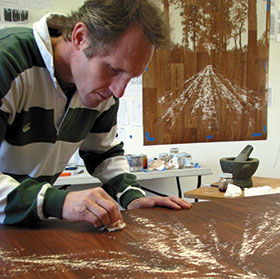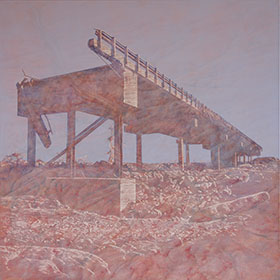 Detachment and Connection
Detachment and Connection
Tony Windberg
It is said that the Pilbara stays with you long after you leave. Clichés aside about the red dust that gets into everything, the truth for me is that it can take a fair while for ideas to take effect. It’s taken a decade for me to follow up a painting, Tempest I, with its ‘sequel’, Tempest II. This time, however, the technique has completely flipped: it’s not about putting paint on, but removing it. The process goes back to a pivotal moment when I was exposed to the ancient rock art on the Burrup Peninsula. I was based in nearby Karratha, that copy-and-paste suburbia in the spinifex. The Burrup, shimmering in the heat haze across the bay, was home to a myriad of images and cryptic signs on countless boulders. These petroglyphs, pecked and chipped into the rust coloured surface, were hauntingly poignant. The marks revealed the lighter rock beneath the dark patina and for me a connection was instantly made, a sudden revelation of applying this to my own art.
I saw a link between this technique and the modern domesticity around me. The kitchen floor had just been replaced, and I seized upon the left over scraps of vinyl flooring. Beneath the fake wood finish with its embossed ‘grain’ was a white substrate. What would happen if I chipped away the veneer? The experiment paid off. The resulting imagery of my Karratha backyard stood out in stark whiteness, yet importantly, so too did the timber planks in all their wood-look wizardry.
 With this oscillating dual reality, a major shift in my thinking had begun.
With this oscillating dual reality, a major shift in my thinking had begun.
But it was not until well after my move to Northcliffe in the cooler south west of Western Australia in 2005, that investigation into the illusion of the picture-plane took off again, this time into the third dimension with wall mounted constructs. The symbolism of engraving into the veneer made new sense with depictions of vegetation removal and bluegum plantations, the process echoing the subject.
The response to a place is both instantaneous and gradual. After departing Perth in 2002 for Meekatharra, the first thing I did was survey the surrounds from the highest nearby hill, a telling step I repeated in Karratha. These notes and sketches in my visual diaries record the things in the landscape that struck me, the brazen evidence of our big human footprint. In Northcliffe, in my ninth year here, I’m still making the connection to place, struggling with the concept of ‘regional artist’, but always looking for new ways of telling the story of our impact on the landscape.
With distance also comes detachment. In Tempest II, my sacrificial scraping back into an earlier oil painting is an act of selective destruction. The painted illusion of great spatial distance – a jet’s-eye view of an apparently benign watercourse cutting through the Pilbara heartland – is shattered. The washed out bridge is engraved into nothing more than paint on red dust on canvas. It is skin deep.
Tony Windberg is a visual artist and part-time lecturer. He works in an expanding range of media, most recently with digitally modified engravings printed onto glass for a Percent for Art Scheme project. Tony holds a B.A. (Fine Arts) from Curtin University.
This article featured in the Artsource Newsletter, Summer 2014/15